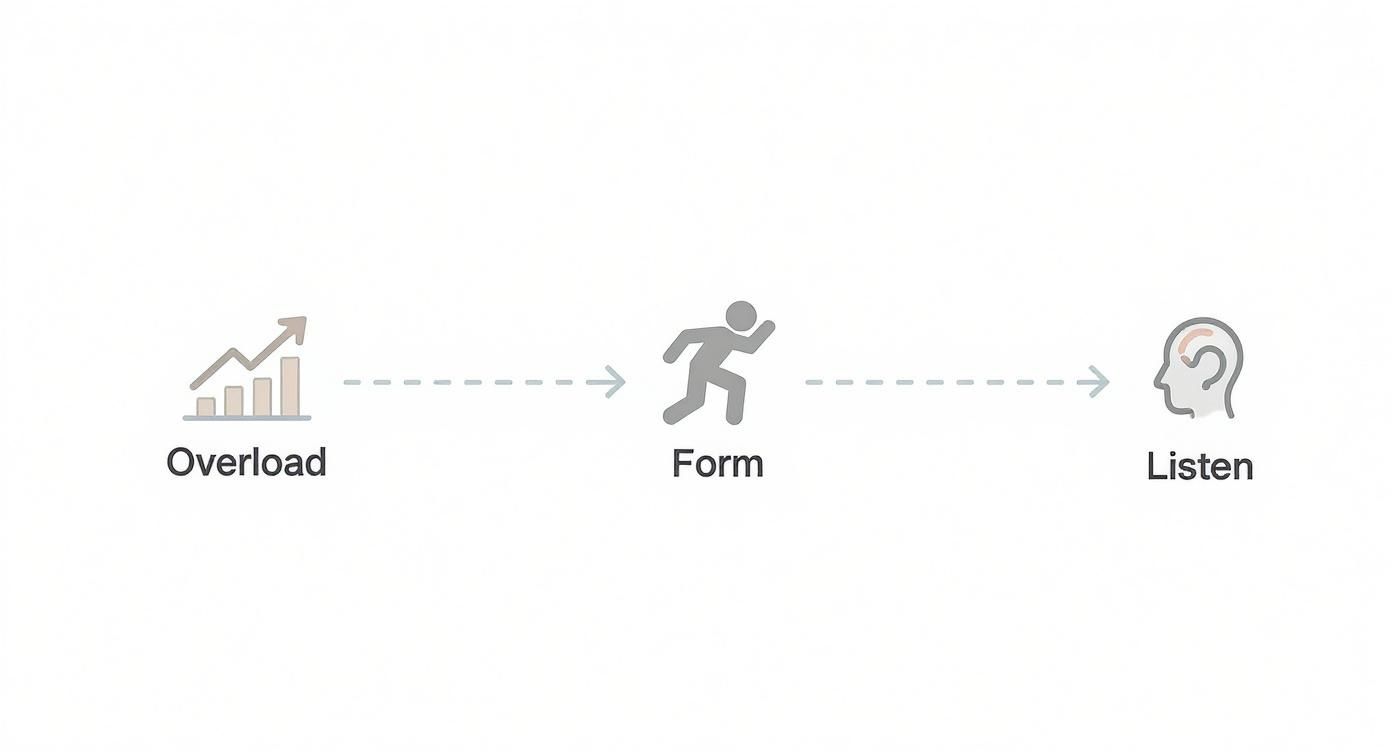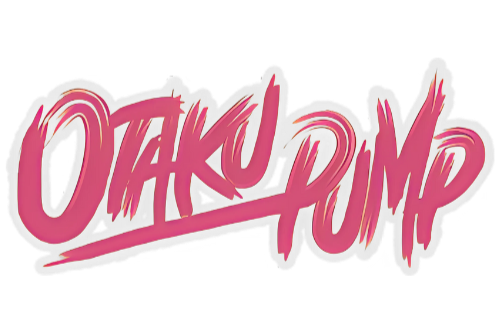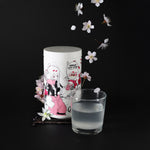Before we dive into how to stop muscle soreness, we need to understand what’s actually happening inside your body. That familiar ache you feel a day or two after a killer workout isn't just a sign you went hard—it's a biological process with a name: Delayed Onset Muscle Soreness (DOMS).
Lots of lifters wear soreness like a badge of honor, but it's not the only—or even the best—indicator of a great workout. DOMS is a whole different beast from that immediate burn you feel mid-set.
So, what's really going on? The primary culprit behind DOMS is microscopic damage to your muscle fibers. When you push your muscles harder than they're used to, either with a new exercise or more intensity, you create tiny little tears in the tissue. Don't worry, this is a totally normal part of building muscle.
Here's the play-by-play:
- Eccentric Movements: These are the real troublemakers. Think about the lowering phase of a bicep curl or the controlled descent in a squat. Any time you're lengthening a muscle while it's under tension, you're causing more of those micro-tears.
- The Body's Response: Your body immediately jumps into action, kicking off an inflammatory repair process. It floods the area with fluids and nutrients to start healing and rebuilding those fibers, making them stronger than before.
- The Ache Sets In: This inflammation, along with the chemical soup from the repair cycle, is what causes that classic stiffness and pain. It’s why you really start to feel it between 24 to 72 hours after your workout.
Note that all claims in this article have not been evaluated by the FDA. Our products are not intended to treat or cure any diseases or conditions.
The Science Behind the Soreness
How sore you get is directly tied to how hard and how long you train. Old-school research has shown this time and time again. A long-distance run, for example, involves a ton of repetitive eccentric contractions, which often leads to more intense and longer-lasting soreness than a quick, high-intensity lifting session.
It just goes to show that both the type and the volume of your training play a huge role in how much you'll be waddling the next day. You can get a deeper understanding of how different exercises affect soreness from this foundational research.
The image below gives you a close-up look at the muscle fibers that take a beating during a tough workout.

Getting a handle on this damage-and-repair cycle is everything. Every single prevention strategy we're about to cover is based on either minimizing that initial damage or giving your body the support it needs to recover like a champ. Get that right, and you can keep discomfort to a minimum and stay on track with your training.
Building Your Pre-Workout Prevention Ritual
Your best defense against that post-workout ache starts long before you even touch a weight. We've all been there—thinking you can roll out of a chair and straight into a heavy set. That's a surefire recipe for days of hobbling around. A solid pre-workout ritual is all about priming your body for the battle ahead.
Forget the generic five-minute jog on the treadmill. To really sidestep muscle soreness, you need a targeted approach that wakes up your muscles, joints, and nervous system for the specific lifts you're about to crush.
Dynamic Warm-Up The Right Way
A dynamic warm-up isn't about holding a stretch and zoning out. It’s about active movements that take your joints through their full range of motion. This gets the blood flowing, raises your core temperature, and makes your muscles more pliable without zapping your strength.
The key is specificity. On leg day, your warm-up should be all about activating your hips, glutes, and hamstrings.
Effective Dynamic Movements:
- Leg Swings: Swing your leg forward-and-back, then side-to-side. You'll feel those hips open right up.
- Arm Circles: Start small and get progressively bigger, going both forwards and backwards to prep the entire shoulder.
- Torso Twists: Gently rotate your upper body to mobilize your spine and switch on your core.
- Bodyweight Squats: These are non-negotiable for leg day. They activate your quads and glutes while dialing in your form.
Just 10-15 minutes of a targeted dynamic warm-up does more than reduce injury risk—it significantly cuts down on the muscle micro-trauma that causes serious DOMS.
For an extra edge, weaving in some essential yoga warm-up exercises can seriously improve flexibility and make your muscles even more resilient to soreness.
Fueling Your Body for Battle
What you put in your body beforehand is just as crucial as your physical prep. Dehydration is a massive contributor to muscle soreness, making it feel worse and last longer. Make sure you're drinking plenty of water all day, not just right before you hit the gym.
Nutrition is the other half of the equation. A snack or meal rich in carbohydrates about 1-2 hours before you train tops off your glycogen stores—your body's high-octane fuel for intense exercise.
This is also where a quality pre-workout supplement can give you a real advantage. The right ingredients increase blood flow, sharpen your focus, and get your muscles ready for work. At Otaku Pump, our anime-inspired pre-workout formulas are designed to boost endurance and power, which helps lessen the overall stress on your muscles during a tough session. A comprehensive pre-training ritual sets the stage for a killer workout and a much happier recovery.
Train Smarter to Keep Soreness at Bay
How you train is just as important as how you prepare. Once you’re in the gym, the goal isn't just to move weight—it's to move it intelligently. Diving headfirst into a new, intense routine or piling on the plates too quickly is a guaranteed recipe for post-workout misery.
The real secret is to work with your body, not against it. That means using strategies that push your muscles to adapt and grow without completely wrecking them in the process.
Ease into Progressive Overload
Progressive overload is the name of the game for getting stronger, but the key word is progressive. It’s the simple idea of gradually demanding more from your muscles over time so they’re forced to adapt. It might sound intense, but the execution needs to be patient.
Don't send a rookie into the boss battle. You have to level up first.
- Reps First, Weight Later: Before you even think about grabbing heavier dumbbells, try adding another rep or two to your sets with the weight you're already using.
- Small Jumps in Weight: Once you can comfortably hit your target reps, add the smallest possible weight increment. Think 2.5 lbs on each side of the bar, not a whole 45-lb plate.
- Technique is a Tactic: Sometimes, the "overload" is just doing the same exercise with better form, more control, or a deeper range of motion.
This slow-and-steady approach gives your muscle fibers the time they need to repair and come back stronger, which seriously cuts down on the shock that causes that can't-walk-down-the-stairs soreness.
Your Form is Your Best Friend
Solid form isn't just about avoiding a trip to the emergency room; it's your best defense against unnecessary muscle pain. As soon as your form starts to break down, you stop working the muscle you intended to. Instead, you start pulling in other, less-prepared muscles and putting a ton of strain on your joints and tendons.
Think about a squat. If your knees start caving in or your back rounds, all that tension shifts away from your quads and glutes and goes straight to your lower back and knee ligaments. Not only does this cheat you out of your gains, but it leaves you sore in all the wrong places.
Pro Tip: Master any new exercise with just your body weight first. Get a feel for the movement and focus on activating the right muscles before you even think about adding weight.
Ultimately, these strategies are all about minimizing that initial hit of Exercise Induced Muscle Damage (EIMD). By starting lighter and gradually increasing the intensity, you give your body a chance to adapt, which is a core principle in clinical approaches for preventing DOMS through gradual adaptation.
Learning to listen to your body is the most crucial skill you can develop. You need to know the difference between the satisfying burn of hard work and the sharp, grinding pain that signals you're going too far. That self-awareness is what will keep you in the gym consistently and out of the physical therapist's office.
Mastering Post-Workout Recovery Techniques
That last rep might feel like the end, but it’s really just the beginning—the start of the most important phase for muscle growth and keeping soreness at bay: recovery. What you do in the minutes and hours after your workout has a massive impact on how stiff and achy you’ll feel for the next 48 hours.
Think of it this way: the workout is the signal, but the recovery is where the real magic happens. You’re just breaking down muscle tissue if you don't give your body the chance to rebuild it stronger. The goal is to jump-start that repair process immediately, flushing out metabolic junk and getting nutrients to your tired muscles.
What to Do the Second You're Done
It all starts the moment you rack the weight. Instead of just collapsing onto the nearest bench, dedicate a few minutes to a proper cool-down. This isn't just about catching your breath; it's about gradually bringing your heart rate down to a normal level and stopping blood from pooling in your limbs.
A solid cool-down is simple. Just five to ten minutes of light cardio will do the trick—think walking on the treadmill or hopping on a bike at a relaxed pace. This keeps your blood moving, which is key for clearing out the exercise byproducts that lead to soreness.
After the light cardio, it's time for some static stretching. Unlike the dynamic, movement-based stretches in a warm-up, these are holds. Pick a stretch for the muscles you just worked and hold it for 20-30 seconds. This helps lengthen those tight muscles, improving your flexibility and easing that immediate post-workout tension.
The biggest mistake people make? Skipping the cool-down entirely. I get it, you're tired. But taking just 10-15 minutes for light cardio and stretching makes a world of difference. It kickstarts the recovery cascade and sets you up for a much less painful next day.
This infographic breaks down the key training principles that make recovery way more manageable from the start.

As the visual shows, smart recovery really begins with smart training. Respecting progressive overload, keeping your form tight, and actually listening to your body are the foundations for preventing the kind of excessive muscle damage that leads to crippling soreness.
Active vs. Passive Recovery Methods
Beyond that immediate cool-down, your recovery strategy should mix both active and passive techniques. Active recovery is all about light movement on your rest days, while passive recovery involves tools or methods that do the work for you.
Here are a few of my go-tos:
- Foam Rolling: This is basically a DIY deep-tissue massage. Rolling over tight spots helps break up knots and adhesions in your fascia (the connective tissue wrapped around your muscles). This boosts blood flow and can seriously dial down that feeling of tightness.
- Massage Therapy: If it's in your budget, a professional massage is one of the best recovery tools out there. A huge meta-analysis confirmed that massage therapy is incredibly effective at reducing DOMS and fatigue. It consistently outperforms other methods for getting your muscles back to full function after a tough workout.
To give you a better idea of what might work for you, here’s a quick comparison of some popular methods.
Comparing Popular Recovery Techniques
Choosing the right recovery methods depends on your goals, budget, and what you find most effective. This table breaks down some common options to help you build your personal recovery toolkit.
| Technique | Primary Benefit | Effectiveness for Soreness | Accessibility & Cost |
|---|---|---|---|
| Static Stretching | Improves flexibility & immediate tightness | Moderate | High / Free |
| Foam Rolling | Reduces muscle knots & fascial restriction | High | High / Low Cost |
| Massage Therapy | Deep tissue repair & reduces inflammation | Very High | Low / High Cost |
| Ice Baths | Reduces inflammation & swelling | High (but debated) | Medium / Low to Medium Cost |
| Active Recovery | Promotes blood flow & nutrient delivery | Moderate | High / Free |
| Compression Gear | Improves circulation & reduces swelling | Moderate | High / Medium Cost |
Ultimately, the best approach is a combination of these techniques. Experiment to see what your body responds to best and what you can realistically stick with.
Of course, none of this works without proper nutrition. Fueling your body correctly is non-negotiable, and certain supplements can give you a serious edge. For a closer look at how specific compounds power the repair process, check out our guide on using amino acids for muscle recovery.
Building your own recovery plan is the key to consistency. For more ideas to get started, explore these Top 6 Post-Workout Recovery Tips for Fitness Enthusiasts.
Fueling Recovery with Smart Nutrition Choices
You can stretch and foam roll all day long, but if your nutrition is off, you're fighting an uphill battle against muscle soreness. Your workout breaks your muscles down. That’s the point. But it’s the food you eat afterward that builds them back up—stronger and more resilient than before.
What you eat right after you train is a total game-changer for avoiding that deep, nagging ache that can last for days.
The clock starts ticking the second you finish your last rep. Think of your muscles as sponges, ready to soak up whatever you give them to kickstart the repair process. This is where protein, carbs, and water become your best friends. If you skimp on any of them, you’re just slowing yourself down.
The Macro Building Blocks of Repair
Protein is the obvious MVP of muscle recovery. It provides the amino acids your body needs to patch up all those tiny micro-tears you created in the gym. Aiming for a solid dose of high-quality protein within a few hours of training gives your muscles the raw materials they need to get the job done right.
But protein can't do it alone. Carbohydrates are just as important. They’re responsible for refilling the glycogen stores you burned for fuel during your workout. This is crucial for re-energizing your muscles so they're ready for your next session. Without enough carbs, your body might start breaking down muscle for energy, which is the last thing you want.
Your body needs protein to repair muscles and carbs to refuel them. It’s like a construction project: protein is the bricks, and carbs are the energy for the crew putting them in place.
Hydration: The Unsung Hero
Never underestimate the power of water. Being dehydrated is one of the biggest enemies of muscle recovery. Your body needs water to shuttle nutrients into your cells and flush out the metabolic waste you created during exercise.
When you're dehydrated, that whole process grinds to a halt, which can make soreness feel way more intense and stick around a lot longer.
A good starting point is to drink 8 ounces of water for every 15-30 minutes of hard training. And if you're a heavy sweater, you’ll probably need even more to stay ahead of the game.
How Pre-Workout Can Support Your Recovery
While you should always build your diet around whole foods, a few key pre-workout ingredients can give your recovery a serious edge. Interestingly, many of the compounds that get you fired up for a workout can also help you cool down afterward.
Take a look at ingredients often found in Otaku Pump's pre-workout formulas:
- Amino Acids: These are the direct building blocks of protein, essential for kickstarting rapid muscle repair and dialing down soreness.
- Citrulline Malate: This is a powerhouse for boosting nitric oxide, which opens up your blood vessels. Better blood flow means more oxygen and nutrients can get to your tired muscles, dramatically speeding up recovery.
This is why a well-formulated pre-workout isn't just about the workout itself; it's about setting the stage for a faster, more complete recovery. It gets your body ready for the work and supports the crucial repair process that comes after.
For a deeper dive into recovery-focused nutrition, check out our guide on the best post-workout recovery foods to build your ultimate refueling plan.
Your Top Muscle Soreness Questions, Answered
Look, even when you do everything right, you’re still going to have questions. A little post-workout ache is just part of the game when you're pushing your body to get stronger.
Let's clear up some of the most common questions that pop up after a killer session. Knowing the answers will help you train smarter, not just harder.
Is It Okay to Work Out with Sore Muscles?
Ah, the classic question. The short answer? It depends.
If you’re just feeling a bit of mild soreness, some light activity can actually be a good thing. Think a brisk walk, a few easy laps in the pool, or even training a completely different muscle group. This gets the blood flowing, which can help speed up your recovery.
But if you’re dealing with moderate to severe soreness—the kind that makes you wince just getting off the couch—hitting those same muscles again is a bad move. Pushing through serious pain is a fast track to injury and can actually make your recovery take longer. In that case, your best bet is to either rest up or stick to some very light, gentle movement.
How Long Does Muscle Soreness Usually Last?
Delayed Onset Muscle Soreness, or DOMS, is a sneaky one. It doesn’t hit you right away. You’ll usually start to feel it about 12 to 24 hours after your workout, and it tends to peak somewhere between 24 and 72 hours.
For most people, the ache will fade away within three to five days. How long it sticks around really depends on a few things:
- The exercise itself: Trying something brand new almost guarantees you'll feel it the next day.
- Workout intensity: If you pushed for an extra set or went heavier than usual, expect the recovery to take a bit longer.
- Your fitness level: The more conditioned you are, the more efficient your body gets at bouncing back.
If you’re in serious pain for more than a week or notice a lot of swelling, it’s probably time to check in with a doctor.
If I'm Not Sore, Did I Not Train Hard Enough?
Absolutely not. This is one of the biggest myths floating around the gym.
While soreness can be a sign of a tough workout, it's not a reliable way to measure how effective it was. As your body gets used to a routine, you’ll naturally feel less sore, even as you’re still making gains and getting stronger.
A much better way to know if your workout was a success is to track progressive overload. Are you lifting a little more weight over time? Can you squeeze out one more rep than last week? Is your form getting better? That's the real proof you’re making progress. Focus on performance, not pain.
Ready to fuel your workouts and support your recovery? Otaku Pump crafts powerful pre-workout formulas designed to help you push your limits and bounce back faster. Check out our anime-inspired supplements to find your new secret weapon at https://otakupump.com.




